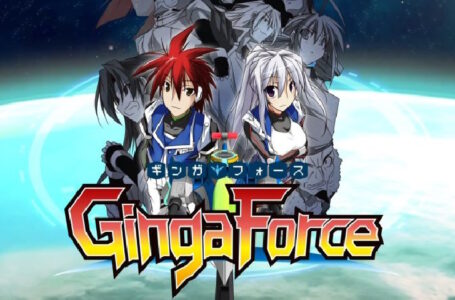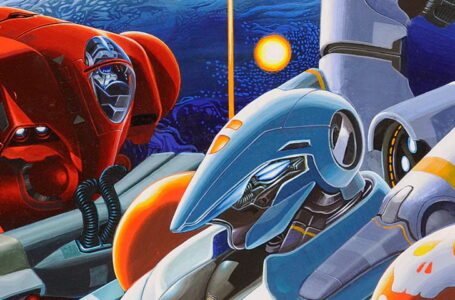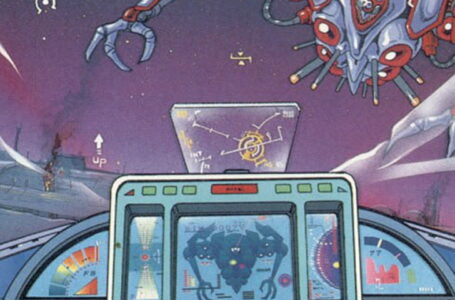Blissful Death: The exhilarating speed of Raging Blasters
If you’re a shoot ’em up fan, you’ve probably come across Shmup Junkie’s channel on YouTube before. If you haven’t, he’s worth a subscribe — his videos cover a wide variety of different shoot ’em ups from over the years from the perspective of someone who has an excellent understanding of mechanics, design and genre conventions.
One game that I’d seen Shmup Junkie recommend on more than one occasion is Raging Blasters. This is an indie title that initially released on Steam, and which has subsequently seen an enhanced Switch port in Japan — the latter should be coming west soon. Such was the enthusiasm of Shmup Junkie for this game — particularly when recommending accessible titles to people who appreciate the genre but are perhaps not all that good at it — that I knew I had to pick it up. Particularly ’cause there’s a Steam sale on at the time of writing.
I did not regret my purchase.
Raging Blasters is a vertically scrolling shoot ’em up that is very obviously heavily inspired by Hudson Soft’s Star Soldier series, a popular installment of which we looked at a few weeks back. Not only does it feature the high-speed action that the Star Soldier series has become known for, it also shares a number of aesthetic elements — notably the use of “space scaffolding” (for want of a better term) for many of its stage backdrops, along with a pulse-pounding soundtrack that really gets you in the mood for some wanton destruction.
On top of that, the game even features a three-minute timed Caravan mode, just like the Star Soldier games, so if you’re in the mood for a quick blast but don’t want to commit to a full runthrough of the game’s eight stages, you’re well catered to.
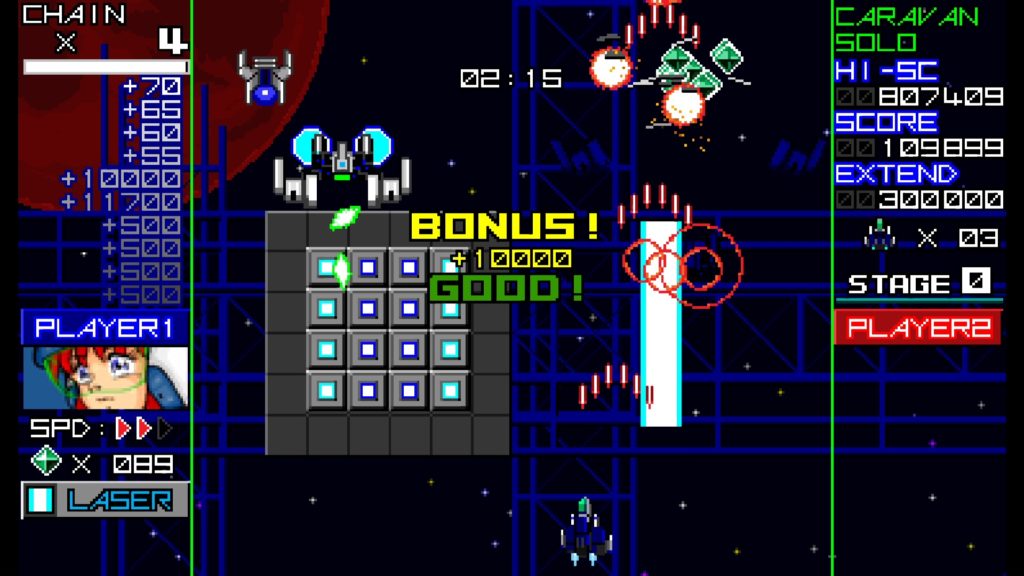
In traditional shoot ’em up tradition, Raging Blasters keeps the plot minimal. You (and, optionally, a friend) are dispatched on “a secret mission” for which the objective is simply given as “destroy the enemy”. From there, you launch into space and immediately into combat against a wide variety of different enemy waves and bosses.
I use the term “waves” deliberately, because Raging Blasters is very obviously designed around individual predefined attack patterns of enemies that appear in sequence rather than unfolding as a single continuous piece of choreography. This is an interesting approach, because it means that rather than — or perhaps as well as — learning levels, you also learn how those small, individual attack patterns work. And this means that when those attack patterns show up in later stages — which they often do — you already know how to deal with them.
This approach to design works well with the exhilaratingly speedy pace at which the game moves, because it allows you to concentrate on each stage a small chunk at a time rather than being overwhelmed with constant barrages of enemies and bullets. You’ll get an attack pattern to deal with, then a brief breather, then another one, then another breather, then another one… and every so often you’ll have a slightly longer period of rest as your ship “accelerates” into the next part of the stage, usually with some sort of beat ’em up style exhortation to “GO NEXT!” or “EXPLOSIONS!”.
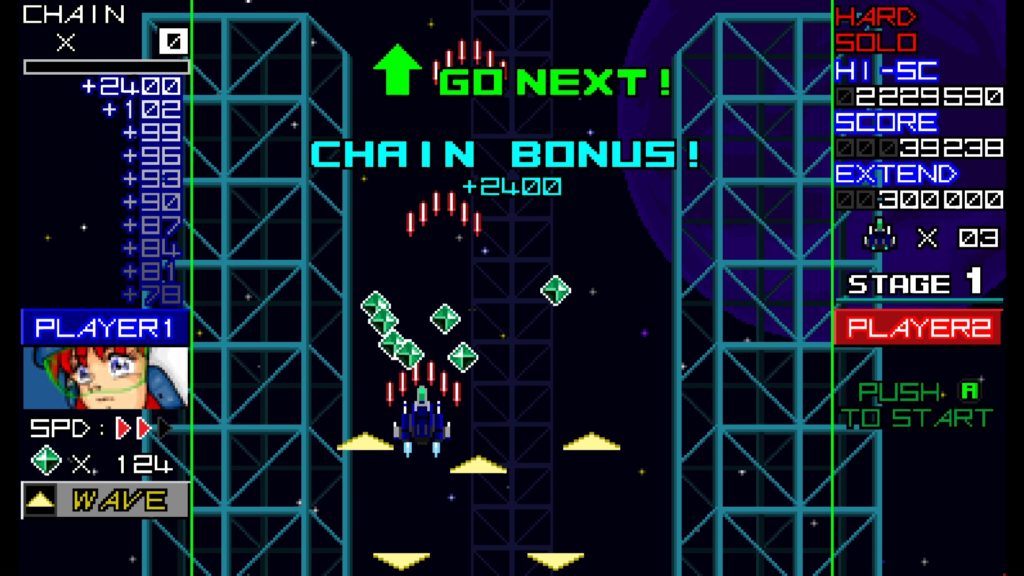
In this sense, Raging Blasters can also be argued to have a certain degree in common with Qute’s classics Judgement Silversword and Eschatos, which are more explicitly designed in brief “areas” that in turn make up longer stages. This approach makes learning and memorising the game a lot easier — and is one of many reasons Raging Blasters is so accessible.
Like several of the Star Soldier games, most of Raging Blasters’ stages feature two bosses — one at the midpoint, and one at the end. Both are timed, with quicker victories resulting in higher scores being awarded.
If there’s one slight drawback to Raging Blasters, it’s that the bosses don’t have a lot of obvious aesthetic appeal to them; they’re mostly relatively bland, abstract mechanical designs. Where they make up for this, though, is in their attack patterns — each is completely unique and requires a very different approach to beat. Sometimes a simple all-out assault alternating with dodging (or destroying) enemy bullets is the best approach, while others will require pinpoint accuracy or creative use of your weapons.
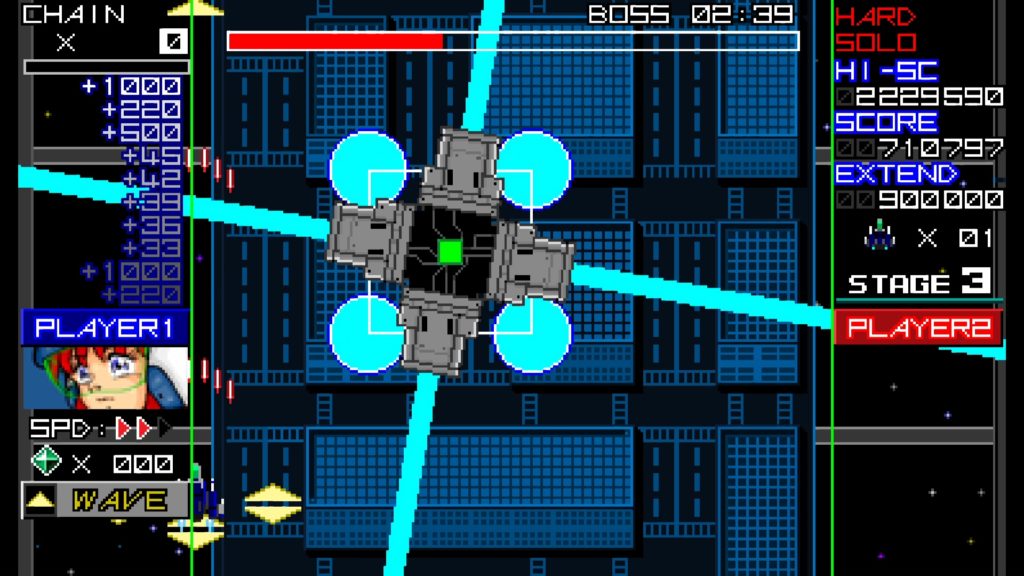
Speaking of weapons, your ship in Raging Blasters has two fire modes: an intense barrage straight ahead, and a “wide” option, which acts similarly to a powered-up red weapon in the Star Soldier series by firing ahead and at 45-degree angles from the four corners of your ship. Your basic weapon cannot be powered up, which also means you can’t lose any shot power by dying — this is a pleasantly considerate piece of design that acknowledges one of the least popular elements of genre classics such as R-Type and Gradius and sidesteps it neatly.
There are collectible subweapons that appear regularly during both the main stages and the boss battles, however, and every one is useful under certain circumstances.
The most consistently handy are the wave shot and the homing missiles, the former of which fires a wide spread of large projectiles and the latter of which is self-explanatory. But each of the others have valid use cases, too, meaning it’s worth learning when they appear — this is fixed in each stage — and the upcoming encounters for which they might be useful.
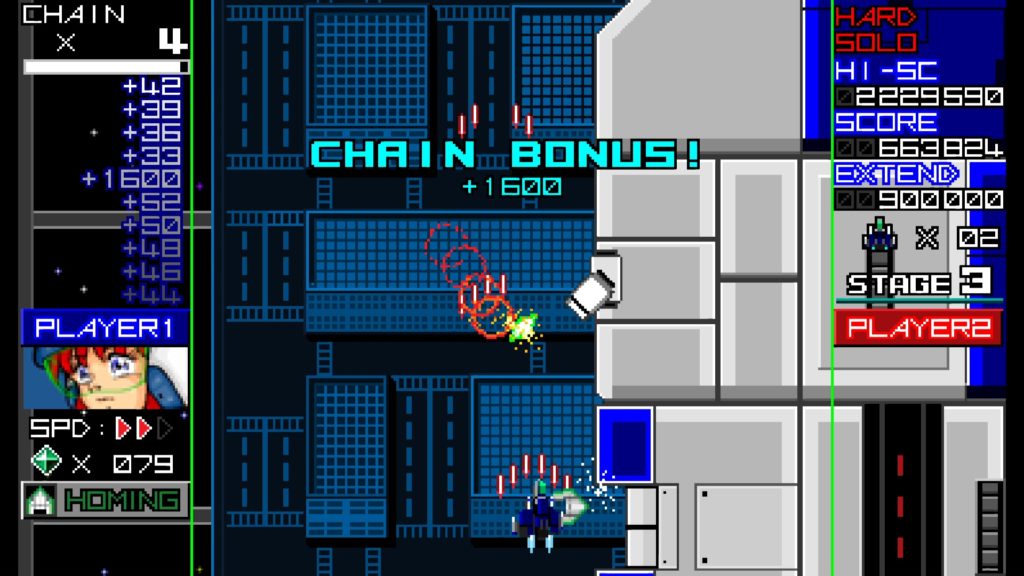
For example, both the laser and fire attacks are useful in that they can pass through otherwise solid objects, with the former dealing continuous damage as its beam passes over any targets, and the latter causing an explosion a short distance ahead of your ship. These are especially useful when dealing with bosses that shield their weak points, since they allow you to continually deal damage when other weapons would find themselves blocked.
The ring weapon, meanwhile, is more of a defensive option, consisting of two energy orbs that rotate around your ship, dealing damage to anything they hit. They also block bullets, making them particularly helpful for situations where you’re surrounded by dense bullet patterns or lots of enemies — though it’s important not to get too overconfident when you have this active, as it’s all too easy to crash into things.
Raging Blasters is not a difficult shoot ’em up — I one-credit cleared it on its normal difficulty on my first attempt — but the longstanding appeal comes from both its harder difficulty levels and its scoring system. The latter in particular strikes an excellent balance between rewarding skilful play and being easy to understand — it’s certainly a far cry from Cave’s more Byzantine affairs.
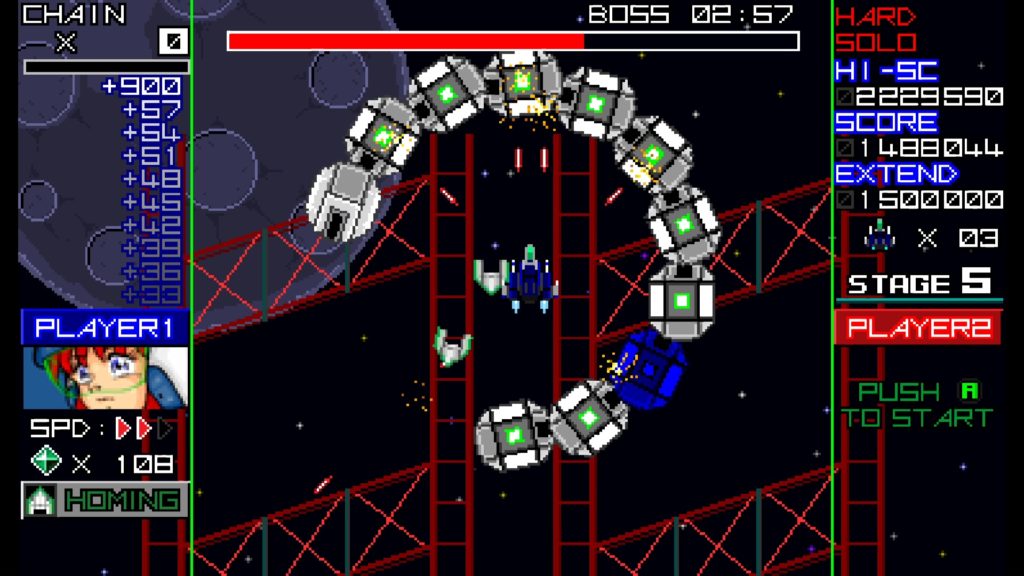
There are two main components to Raging Blasters’ scoring mechanics. First is the fact that for every complete enemy wave you defeat, a shower of gems comes flying in your direction. If you get close enough, these are sucked in to your ship, but as always you’ll need to make sure that you don’t get so greedy you ignore enemy bullets or ships. At the end of a stage, you’ll get a bonus according to how many gems you have — but dying at any point causes you to drop all your gems. So if you’re going to lose a life, try and make it towards the beginning of a stage!
The second is the game’s chain system, whereby the more enemies you destroy in succession, the more points each one is worth and the higher a chain counter climbs. If you take too long to destroy another enemy, your chain will reset and you’ll get a flat bonus according to how high the chain reached.
Under ideal circumstances, you’ll want to keep your chain going for as long as possible, particularly in the Caravan mode, where score is all-important. As such, Raging Blasters rather generously also adds to your chain and provides points when you destroy bullets — this allows you to keep a chain going even during boss battles. Caravan mode also features a number of “ground” targets throughout its stage, allowing you to use these to maintain your chain between main enemy waves appearing, or during boss encounters.
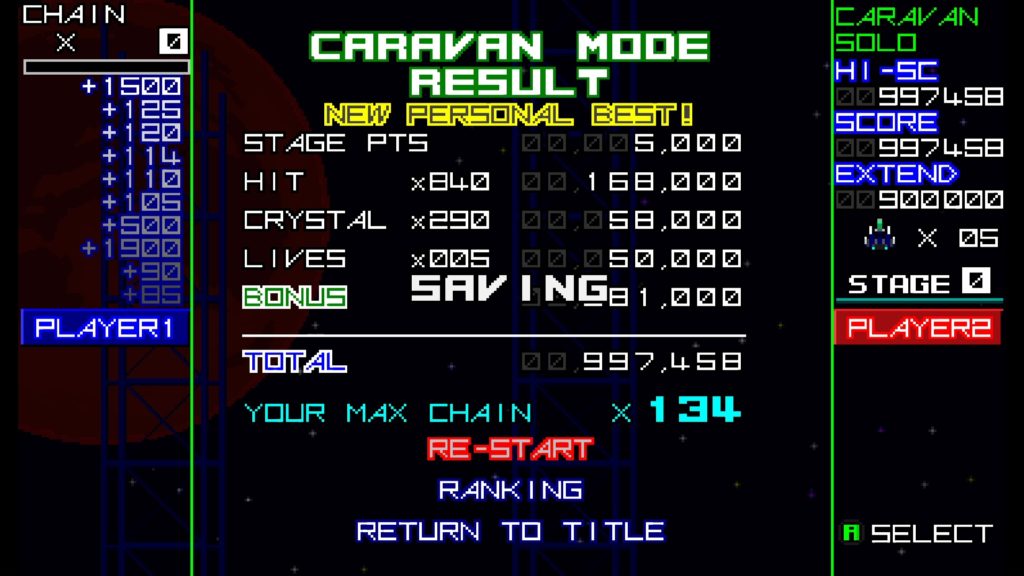
The chain mechanic can be tricky and unforgiving, but it’s easy to understand — and that means once you’ve mastered clearing the game on a single credit, it’s easy to know what you should be focusing on next in order to improve your scores.
The game also keeps track of your best score for each of the game’s stages on a per-difficulty basis, allowing you to see how each run is stacking up according to your best ever performance, and both local and online leaderboards round out a complete package for those who like to get a little competitive with their shoot ’em ups.
On top of all this, Raging Blasters has one of the most astonishingly excellent soundtracks I’ve heard in a game like this for a long time. Composed by HIRROKEY, Raging Blasters’ music combines the frantic energy of DM Ashura’s excellent Gundemonium soundtracks with the tuneful, retro-inspired melodies of Yousuke Yasui’s work. There’s a real sense of progression and wordless narrative as the music progresses — which more than makes up for the almost total absence of explicit story in the game itself, even at the conclusion — and, to be perfectly honest, I find myself booting up Raging Blasters to enjoy the music as much as I do the excellent shooting action.
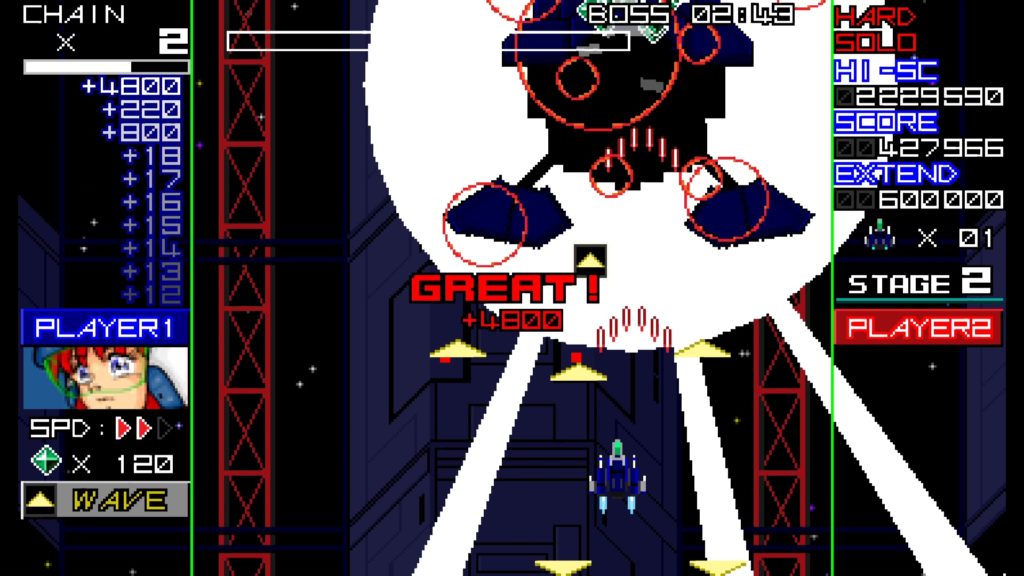
To put it simply, Shmup Junkie was absolutely right to rave about this game. It’s absolutely fantastic, and should be considered an essential purchase for any discering shoot ’em up fan — particularly if you enjoy the Star Soldier series. Now we just need to find someone up for publishing a nice physical release of that Switch version!
Join The Discussion
Rice Digital Discord
Rice Digital Twitter
Rice Digital Facebook
Or write us a letter for the Rice Digital Friday Letters Page by clicking here!
Disclosure: Some links in this article may be affiliate links, which means we may earn a small commission if you make a purchase after clicking on them. This is at no additional cost to you and helps support Rice Digital!
- Letter from the Editor: passing the torch - June 30, 2023
- Super Woden GP 2 is looking promising - June 30, 2023
- Inti Creates is making a 32 bit-style Love Live action platformer - June 26, 2023





